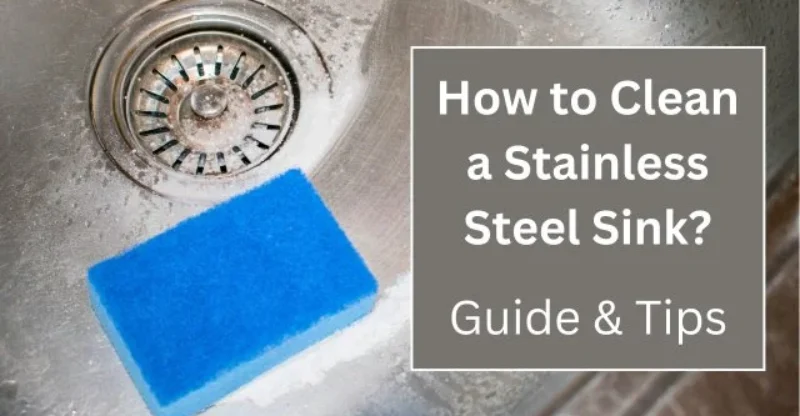How to Clean a Stainless Steel Sink – Guide & Tips
Cleaning a stainless steel sink is an essential task that ensures the hygiene of your kitchen and maintains its aesthetic appeal.
A well-maintained sink can be a shining centerpiece in your kitchen, while a neglected one can become an eyesore.
This guide will provide you with comprehensive information on how to keep your stainless steel sink sparkling clean.
Why Stainless Steel Gets Stains and How to Prevent It
Stainless steel, despite its name, is not completely stain-proof. It’s an alloy made from iron and chromium, which forms a passive protective layer on the surface.
This layer is crucial as it prevents stains and rust. However, it can be damaged by certain substances. For instance, leaving salty or acidic foods on the sink for too long can cause pitting corrosion.
Note: This website is supported by readers and if you click on our links we may earn a commission and as an Amazon Associate, we earn from qualifying purchases.
Therefore, it’s important to rinse your sink regularly, especially after using it.
Essential Tools and Materials
You’ll need:
- Baking soda
- Vinegar or lemon juice
- A soft sponge or cloth
- Warm water
Baking soda is a mild abrasive that can remove stains without scratching the surface. Vinegar or lemon juice, on the other hand, is acidic and can help dissolve mineral deposits and brighten the sink.
Daily Cleaning Routine for a Stainless Steel Sink
A simple daily cleaning routine is all it takes to maintain the shine and cleanliness of your stainless steel sink. After each use, a quick rinse with warm water to remove food particles or residues, followed by a wipe with a soft cloth.
This prevents water spots and mineral deposits from forming, which can dull the sink’s surface. It’s easy and you can do it!
Deep Cleaning Process: Step-by-Step Instructions
Let’s see the detailed steps on how to clean stainless steel:
1 – Pre-cleaning and Rinse
Before you begin the deep cleaning, remove any dishes or debris from the sink. Rinse the sink with warm water to remove loose particles, preparing it for the cleaning treatment.
2 – Applying Baking Soda and Scrubbing
Sprinkle a sufficient quantity of baking soda throughout the sink. It’s a mild abrasive that removes grime and stains without scratching the surface.
Using a soft sponge or cloth, scrub the sink following the grain of the stainless steel. This helps lift and remove dirt without damaging the finish.
3 – Using Vinegar or Lemon Juice for Tough Stains
Apply vinegar or lemon juice to the area with tougher stains or mineral deposits. The acidity of these substances helps dissolve the deposits.
Let it sit for a few minutes, then scrub with a sponge or cloth. Rinse thoroughly with warm water.
4 – Rinse and Dry
After scrubbing the sink, rinse it thoroughly with warm water to remove all baking soda, vinegar, or lemon juice residue.
After washing the sink, dry it thoroughly using a soft cloth. This final step is crucial as it prevents water spots and gives your sink a nice shine.
Alternative Cleaning Methods
If you’re looking for alternative cleaning methods, there are several options. Club soda can give your sink a nice shine. Just pour some club soda on a cloth and wipe the sink.
Cream of tartar and hydrogen peroxide make a great cleaning paste for stubborn stains. Ash is a traditional cleaning agent that can be used to scrub away tough grime.
Even toothpaste can be used to remove minor, stubborn stains. These methods can be effective alternatives to the baking soda and vinegar or lemon juice method.
How to Avoid Scratches and Damage
Stainless steel sinks are not just beautiful, they’re also durable. While they can get scratched or damaged with rough handling, following some simple preventive measures can keep your sink looking new
. This reassurance should give you confidence in your choice of a stainless steel sink.
- Avoid harsh or abrasive cleaners and steel wool, which can scratch the surface.
- Only briefly leave pots, pans, or cutlery in the sink, as they can cause rust stains.
- Use a sink protector or mat to prevent scratches from dishes and cutlery.
- Avoid putting hot water directly into the sink since this could lead to thermal shock and damage.
Do’s and Don’ts for Maintaining a Stainless Steel Sink
To maintain the quality of your stainless steel sink, follow these dos and don’ts:
- Do rinse your sink after each use to prevent stains and corrosion.
- Please don’t use bleach or chlorine cleaners, as they can damage the surface.
- Do dry your sink after washing to avoid water spots and mineral deposits.
- Don’t leave acidic or salty foods in the sink for too long, as they can cause pitting corrosion.
Conclusion
Maintaining a clean, shiny stainless steel sink is not just about aesthetics; it’s a satisfying accomplishment. It’s about hygiene and prolonging the life of your sink.
With the right tools, techniques, and time, you can keep your stainless steel sink looking as good as new. Remember, the key is regular cleaning and proper care.
FAQs
For regular maintenance, it’s best to clean your sink daily. However, a deep clean can be done once a week or as needed.
It’s best to avoid bleach as it can damage the protective layer of the sink, leading to rust and stains.
Minor scratches can be buffed with a non-abrasive cleaner and a soft cloth. For deeper scratches, a professional repair service may be needed.



